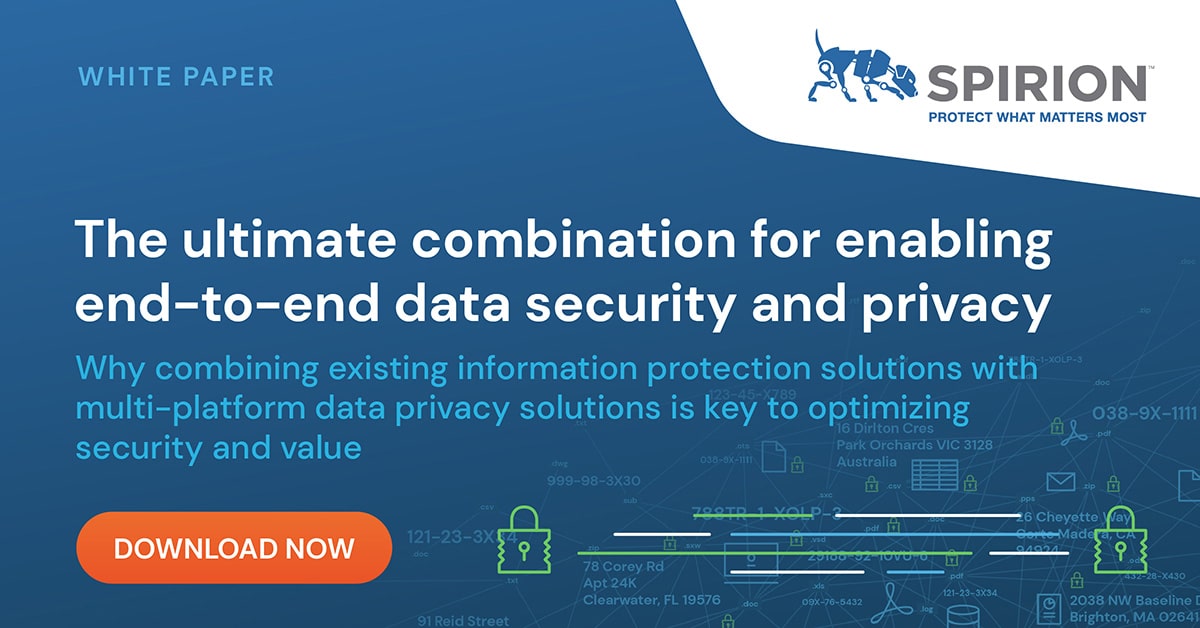Data is the coin of the modern business realm. It’s created entirely new industries and transformed the way companies of all sizes, in every industry operate. But along with the possibilities the explosion of data brings, it’s also creating a litany of new and complex challenges for IT, security, and privacy professionals around protecting it throughout its lifecycle and across ever-growing IT ecosystems.
Today’s businesses own extensive IT landscapes and ever-expanding perimeters spread data to the farthest reaches of the business footprint, across on-prem and cloud platforms, and in a variety of formats. The sheer volume of data — not to mention its disparate and widespread nature — makes effectively locating it, properly classifying it according to its sensitivity level, and implementing an information protection strategy using conventional means and methods nearly impossible.
Add to it the rise of privacy regulations like the GDPR, CCPA, and HIPAA (among multitudes of others) and the demand for a robust approach to minimizing the risk of costly, brand-damaging breaches and violations, many organizations are reevaluating their approaches to preserving the privacy and security of sensitive data.
How information protection strategies are shifting
Traditionally, enterprises have often relied on vendor-supplied information protection tools. Microsoft, for example, offers Microsoft Information Protection (MIP) and Azure Information Protection (AIP) to label and classify data within the Microsoft and Azure environment. But today’s enterprises are increasingly adopting a multicloud business strategy and spending as much as 35% more annually on private and public cloud options than in the past.
And, given that their data will naturally end up living in one or more of those platforms at any given time, organizations need a data-centric approach to protection. They’re now seeking vendor-agnostic solutions to help them gain visibility and transparency into their data across systems, platforms, and environments.

Challenges to sensitive information protection
Pretty much every organization is aware of the need to protect data, but there are many obstacles preventing them from implementing a full data governance program. In particular, they tend to struggle with how to prioritize data protection, how to provide coverage for an ever-expanding data universe, and how best to deal with the complexities of structured, unstructured, and semi-structured or synthetic data.
The end result is substantial blind spots that dramatically increase the risk of breach, unauthorized access, inappropriate use, and compliance failures.
Limited focus on the whole data lifecycle
Many companies tend to focus their attention on preventing unauthorized network access by building firewalls or other network intrusion solutions — usually at the expense of other critical activities like classification and usage control that focus on the data itself. Fortifying defenses against intrusion is an important element of any data privacy and protection strategy, but doing it without consideration for other parts of the strategy can ultimately make collaboration harder, drive down business productivity, and still leave sensitive data exposed.
Data is all over the place
The data in a modern IT ecosystem is diverse and spread out. It lives across platforms and operating systems, in various cloud storage applications, across cloud environments, and in both unstructured and structured formats. Storing sensitive data in such a wide variety of operating systems, cloud environments, and objects can make it nearly impossible to discover, classify, and apply appropriate usage restrictions — especially with outdated manual processes or vendor-locked solutions that only cover a small sliver of the overall data inventory.
Data formatting can create huge headaches
Data itself isn’t homogenous. It comes in a variety of formats — structured, unstructured, semi-structured, or some combination of the three. Adding to the challenge, each category of data requires its own standards around the levels of access people and other systems have, creating additional obstacles to properly and sufficiently discovering, classifying, and remediating it. That’s especially true when dealing with personal identification information (PII) and trying to navigate the myriad compliance requirements for different governance standards that can sometimes conflict with one another.
How to enhance sensitive information protection for comprehensive data governance
Forward-looking enterprises increasingly recognize the potentially existential risks and shortcomings associated with relying on vendor-specific tools for sensitive data governance, and supplementing them with platforms that unify data protection across the data lifecycle.
These comprehensive platforms take the crucial initial steps of data discovery and classification to eliminate blindspots and enable organizations to govern data no matter where it lives.
Sensitive data discovery
First, they use sophisticated techniques to discover data across platforms, systems, and environments. These techniques go beyond pattern matching and RegEx algorithms, employing advanced tools and logic to reduce false positives.
Persistent data classification
Next, they classify both structured and unstructured data in alignment with their broader data governance programs, enabling greater granularity and control than legacy systems had ever thought to provide. Specifically, this involves semantic tagging based on level of sensitivity, internal privacy policies, and of course, widespread regulation requirements.
From there, the platforms are able to apply the right policies to the right data at the right times, automatically. As the data interacts with other security solutions throughout the ecosystem, its universally recognized naming conventions eliminate any confusion around what the data is, maximizing the abilities of tools like Microsoft’s AIP or others for assigning user access roles and reporting, and ultimately delivering a more fortified security infrastructure.
This comprehensive, end-to-end data lifecycle coverage substantially reduces the exposure and risk of an organization’s most sensitive data, helping to protect against catastrophic breaches, purposeful and accidental misuse, and enabling them to serve their customers and their business with confidence.
Secure sensitive data where it lives with Spirion
To learn more about how progressive organizations are combining MIP and AIP with Spirion’s expansive platform to secure sensitive information at its source and provide end-to-end data governance across the enterprise, download our white paper, The Ultimate Combination for Enabling End-to-End Data Security and Privacy.



